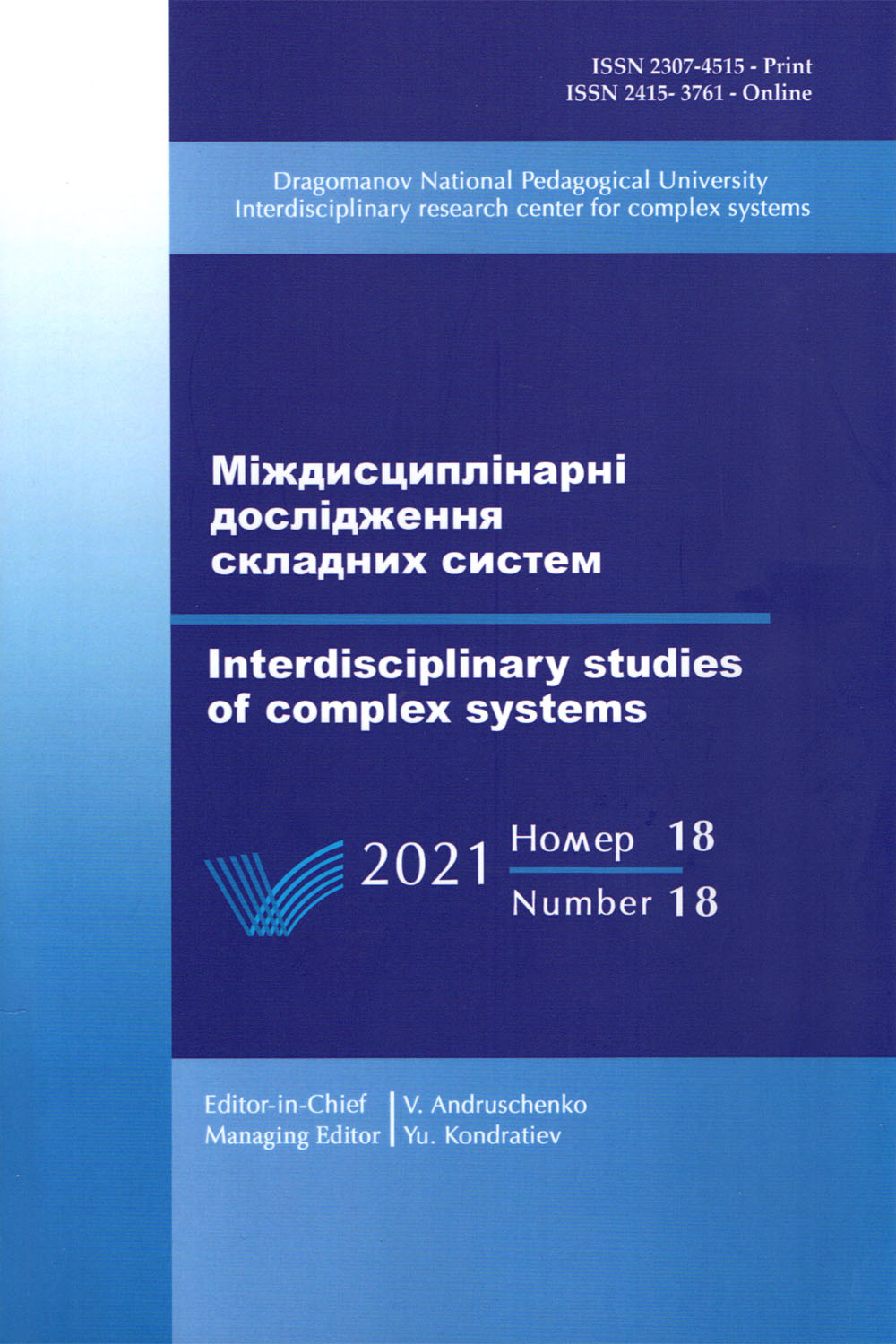METHODS OF DECODING DATA USING BIOLOGICAL RESEARCH AND ARTIFICIAL INTELLIGENCE IN CULTURE PRACTICE
DOI:
https://doi.org/10.31392/iscs.2021.18.005Анотація
Abstract. The article is a comprehensive analysis of projects aimed at studying AI technologies and culture interaction. The author examines the specifics and uniqueness of art works created through AI-technologies using examples of projects from “ThoughtWorks Arts Global Research”, “Innovation Laboratory of New Technologies”, “Isolation Foundation” and “IZONE Creative Association”. The article analyzes the principle of selection of materials, algorithmic analysis of data, the interdependence of digital data received from the user's brain impulses with audiovisual content, the possibility of instant data processing in the process of creating an artistic product. The author explores the principles of tracking brain function and decoding human genetic data, which are used to create art projects. The article assesses the potential that AI possesses and explains the conditions necessary for the implementation of AI-technology in culture. As a result of the study, the author revealed that through algorithmic analysis it is possible to transform digital data into a system of expressive signs of visual and sound arts, to broadcast the received audiovisual content. The author finds out that through these technologies it is possible to create interactive art forms (interactive film, installations, immersive presentations, etc.).
Посилання
Boddington, P. 2017. Towards a code of ethics for artificial intelligence.
Cham: Springer Nature Switzerland.
Bostrom, N. 2014. Superintelligence: paths, dangers, strategies. Oxford:
Oxford University Press.
Bourdieu, P. 1993. The field of cultural production: essays on art and
literature. New York: Columbia University Press.
Burnham, J. 1975. Beyond Modern Sculpture: The Effects of Science
and Technology on the Sculpture of This Century. New York : George
Braziller.
Chalmers, D. 2010. The singularity: a philosophical analysis. Journal of
Consciousness Studies, 17: 7–65.
Coeckelbergh, M. 2012. Can we trust robots? Ethics and Information
Technology, 14: 53–60.
Donahue Michelle Z. 2017. How a Color-Blind Artist Became the World’s
First Cyborg, National Geographic. https://www.nationalgeographic.com/
news/2017/04/worlds-first-cyborg-human-evolution-science (Accessed 15
May 2020).
Drexler, K. E. 1986. The Coming Era of Nanotechnology. Anchor Books:
Doubleday.
Fraser J. 2017. A primer on AI in financial services. https://medium.com/
@jeffrey.fraser/primer-on-ai-in-financial-services-686640bd0a61 (Accessed 27
April 2020).
Gilson, E. 2018. John Duns Scopus: introduction to his fundamental positions. Edinburgh: Bloomsbury T&T Clark.
Gladden, M. E. 2014. The social robot as “charismatic leader”: a phenomenology of human submission to nonhuman power. Frontiers in Artificial Intelligence and Applications, 273:329–339.
Good, I. J. 1965. Speculations Concerning the First Ultra intelligent Machine. Advances in Computers, 6:31–88.
Heather, D. 2020. Stranger Visions. https://deweyhagborg.com/projects/
stranger-visions (Accessed 5 June 2020).
Hofstadter, Douglas R. 1999. G¨odel, Escher, Bach: An Eternal Golden
Braid. New York: Basic Books.
Howard, D., & Muntean I. 2017. Artificial moral cognition: moral functionalism and autonomous moral agency. Philosophy and Computing:.
Essay in Epistemology: 121–159.
Hofstadter, D. R. 1999. G¨odel, Escher, Bach: An Eternal Golden Braid.
New York: Basic Books.
Kreutzer, Ralf T., & Sirrenberg, M. 2019. Understanding Artificial Intelligence: Fundamentals, Use Cases and Methods for a Corporate AI
Journey. Cham: Springer Nature Switzerland.
Langton, C. 1989. Artificial Life: Proceedings of An Interdisciplinary
Workshop On The Synthesis And Simulation Of Living Systems. Boston :
Addison–Wesley.
Lovejoy, M. 2004. Digital Currents: Art in the Electronic Age. London:
Routledge.
Moore, G. 1975. Progress in Digital Integrated Electronics. International
Electron Devices Meeting, IEEE: 11–13.
Pask, G. 1971. A comment, a case history and a plan. Cybernetics. Art
and Idea: 76–100.
Pearlman, E. 2017. Brain Opera Exploring Surveillance in 360-degree
Immersive Theatre. A Journal of Performance and Art, 39: 79–85.
Penrose, R. 2016. The Emperor’s New Mind: Concerning Computers,
Minds, and the Laws of Physics. London: Oxford.
Popper, F. 2007. From Technological to Virtual Art. London: MIT Press
Cambridge.
PWC. 2017. Artificial intelligence and digital labor in financial services.
https://www.pwc.com/us/en/industries/financial-services/research-institute/
top-issues/artificial-intelligence.html (Accessed 20 June 2020).
Searle, John R. 1980. Minds, Brains, and Programs. The Behavioral and
Brain Sciences, 3: 417–457.
Sutrop, M. 2019. Should we trust artificial intelligence? Trames, 23:499–
Riefe J. 2020. Rise of the cyborgs: “I can feel events in Japan when I’m
in New York”, The Guardian. https://www.theguardian.com/artanddesign/
/jul/03/cyborgs-future-technology-global-events-awareness-japan-new-york
(Accessed 20 June 2020).
Vinge, V. 1993. The Coming Technological Singularity: How to Survive
in the Post-Human Era. Vision–21: Interdisciplinary Science and Engineering in the Era of Cyberspace: 11–22.
Whitelaw, M. 2004. Metacreation: Art and Artificial Life. London: MIT
Press (Leonardo books).
##submission.downloads##
Опубліковано
Номер
Розділ
Ліцензія
Автори, які публікуються у цьому журналі, погоджуються з наступними умовами:- Автори залишають за собою право на авторство своєї роботи та передають журналу право першої публікації цієї роботи на умовах ліцензії Creative Commons Attribution License, котра дозволяє іншим особам вільно розповсюджувати опубліковану роботу з обов'язковим посиланням на авторів оригінальної роботи та першу публікацію роботи у цьому журналі.
- Автори мають право укладати самостійні додаткові угоди щодо неексклюзивного розповсюдження роботи у тому вигляді, в якому вона була опублікована цим журналом (наприклад, розміщувати роботу в електронному сховищі установи або публікувати у складі монографії), за умови збереження посилання на першу публікацію роботи у цьому журналі.
- Політика журналу дозволяє і заохочує розміщення авторами в мережі Інтернет (наприклад, у сховищах установ або на особистих веб-сайтах) рукопису роботи, як до подання цього рукопису до редакції, так і під час його редакційного опрацювання, оскільки це сприяє виникненню продуктивної наукової дискусії та позитивно позначається на оперативності та динаміці цитування опублікованої роботи (див. The Effect of Open Access).











